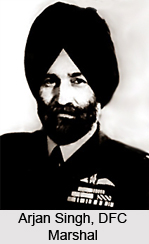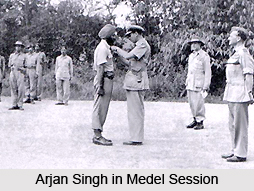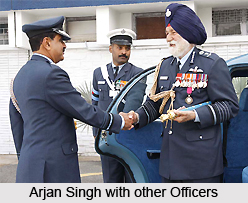 Arjan Singh, DFC Marshal, was born to Kishan Singh and Kartar Kaur on April 15, 1919, at Kohali village in Lyallpur, presently in Pakistan.
Arjan Singh, DFC Marshal, was born to Kishan Singh and Kartar Kaur on April 15, 1919, at Kohali village in Lyallpur, presently in Pakistan.
Arjan Singh`s early years of life had commenced in a typical manner that was likely for a son during pre-partitioned times. Risaldar Bhagwan Singh, Arjan Singh`s grandfather, had moved to Lyallpur district from Amritsar district, since the land there was well irrigated by canals. This was a part of the migration during the late 1800s when people moved from eastern Punjab to the western districts because the irrigation system developed by the British was more resourceful. Often a number of families from a particular village would migrate and form a new village that would share its name with the original one. Thus, the village in Lyallpur district was a branch from Kohali village, near Amritsar. Lyallpur, presently in Pakistan, is called Faislabad. Other members of Risaldar Bhagwan Singh`s family also settled in the village.
Bhagwan Singh`s son Kishan Singh did not however stay back in the village. He studied in Lyallpur and then earned his B.Sc. degree at Khalsa College, Amritsar, where the legendary G. A. Wathen was Principal. He then travelled to England soon after Arjan Singh`s birth in 1919 and spent four years in Edinburgh University, Scotland, where he studied civil engineering. On his way back, his ship docked at Colombo and he became an engineer in Ceylon Railways. He served in Ceylon Railways for a long time.
According to Arjan Singh, he possesses fond memories of his grandfather from his early life. He was still a child when his grandfather died. Singh remembers that the funeral procession had a band included in it, since the custom during those times were that if someone expired at a ripe old age, the death was commemorated with a band. Arjan Singh`s family were not landlords, but were quite contentedly placed.
Arjan Singh studied in the Government High School, Montgomery, which was a comparatively superior school in the region. Singh particularly recollects his schoolmate Justice Manmohan Singh Gujral, who presently resides in Chandigarh. Singh learned to swim in a canal that was located within his family`s farm and the school. That placed him in good position because he captained the school, college, university and the provincial swimming teams. Singh held two long-distance national records in freestyle swimming-one mile and half mile.
Into a rather advanced stage in his early life, Manmohan Gujral and Arjan Singh joined Government College, Lahore, together. Singh stayed in a hostel called the Quadrangle, since it was cheaper and nearer to the swimming pool. He would swim 20-30 lengths every morning and then attend classes. Professor Ward from Cambridge was his favourite professor, but he lost contact with him after leaving the college. Professor G. D. Sondhi, who became the Principal later, guided his students in swimming and Kabaddi and had an immense influence on Arjan Singh.
 Arjan Singh is proud of his college colours in swimming, gatka, athletics and kabaddi, but he never neglected his studies. He earned an Inter-Art degree, FA, for which he also studied mathematics and physics. Singh was in the fourth year of college, when he was selected for the Indian Air Force and had to leave college a few months before he finished the B.A. degree. This was a significant stage in Singh`s early life, which later on was to take a lead role in his being. Along with six or seven students from Lahore, he had taken the defence examination at Metcalf House, Civil Lines, Delhi. Five were selected from the gang. They included Prithipal Singh who belonged to the royal house of Patiala.
Arjan Singh is proud of his college colours in swimming, gatka, athletics and kabaddi, but he never neglected his studies. He earned an Inter-Art degree, FA, for which he also studied mathematics and physics. Singh was in the fourth year of college, when he was selected for the Indian Air Force and had to leave college a few months before he finished the B.A. degree. This was a significant stage in Singh`s early life, which later on was to take a lead role in his being. Along with six or seven students from Lahore, he had taken the defence examination at Metcalf House, Civil Lines, Delhi. Five were selected from the gang. They included Prithipal Singh who belonged to the royal house of Patiala.
In 1938, travelling to England for Arjan Singh was quite enjoyable. A Peninsular and Orient (P&O) liner sailed across the high seas, passing through Aden, the Suez Canal and Gibraltar. Prithipal Singh, Arjan Singh and another cadet from India, took such a liner and reached England for their training. When the group joined Cranwell, Prithipal always came to the top, but by the time they passed out, Singh was the topper." They were the only outlanders; while Arjan Singh had to put in an extra effort to speak English, Prithipal Singh, who had been brought up by British governesses, had a smooth sailing in speaking English. If a word was mispronounced, the instructor made the essential correction and suggested a remedy for it; the emphasis in training was on the development of one`s character in order to become a disciplined officer. The training involved not just flying, but much more than that. Among those who left lasting impressions on Arjan Singh since his early life, were Sergeant Harries, the flying instructor and Squadron Leader D. A. Boyle, the Chief Flying Instructor, who was later knighted and became Marshal of the Royal Air Force.
Life at Cranwell involved studying a lot of mathematics, physics, electronics and engineering, with a complete loss of social life when the college was in session. During weekends, Arjan Singh and his co-cadets went to London to meet Indian friends, though often the British cadets would invite the Indians to their homes on weekends. They remained in touch with each other for decades, especially Marshal of the Royal Air Force Sir John Grandy, GCB, GCVO, KBE, DSO and the late Marshal of the Royal Air Force Lord Samuel Charles Elworthy, KG, GCB, CBE, DSO, LVO, DFC, AFC, who was a New Zealander. Both were his opposite numbers when Arjan Singh was Chief of Air Staff.
Arjan Singh was a clever man, who always perhaps planned for a well-established future. As an outcome to this matter in Singh`s early life, he kept his flying log book in which his entire flying career was noted. An early entry bears witness about the meticulous care they exercised during those days. When Boyle noticed that blue and black inks had been used for making entries in the log book, he observed: "By using the same ink and the same pen, you would improve the appearance of the log book." It can also be also noticed that "Flight Cadet A. Singh" got an "Average" in flying, which rose to "Above Average" on December 22, 1939. He was awarded colours in swimming, athletics and hockey and was the Vice-Captain of the teams for these sports.
 When the Second World War began to take considerable shape in Europe in September 1939, Arjan Singh and his friends` training were cut short due to the shortage of pilots in the Air Force and they were commissioned in December, 1939. There was a shortage of pilots everywhere; in the Royal Air Force in Britain and the Indian Air Force in India, which had only one squadron at Ambala. Prithipal Singh and Arjan Singh were the last two officers to join the squadron in January 1940. This Indian squadron had been grouped on April 1, 1933 at Drigh Road, Karachi by the first batch of airmen, who were called the Hawai Sepoys and a few officers (including Subroto Mukherjee, who later became the first Indian Air Chief) and was commanded by a RAF officer. Originally, it had four Westland Wapitis (a fabric bomber/reconnaissance biplane, typical of the RAF (Royal Air Force) aircraft during the inter-war period). The joining of these two officers brought the squadron to its full strength in 1940.
When the Second World War began to take considerable shape in Europe in September 1939, Arjan Singh and his friends` training were cut short due to the shortage of pilots in the Air Force and they were commissioned in December, 1939. There was a shortage of pilots everywhere; in the Royal Air Force in Britain and the Indian Air Force in India, which had only one squadron at Ambala. Prithipal Singh and Arjan Singh were the last two officers to join the squadron in January 1940. This Indian squadron had been grouped on April 1, 1933 at Drigh Road, Karachi by the first batch of airmen, who were called the Hawai Sepoys and a few officers (including Subroto Mukherjee, who later became the first Indian Air Chief) and was commanded by a RAF officer. Originally, it had four Westland Wapitis (a fabric bomber/reconnaissance biplane, typical of the RAF (Royal Air Force) aircraft during the inter-war period). The joining of these two officers brought the squadron to its full strength in 1940.




















